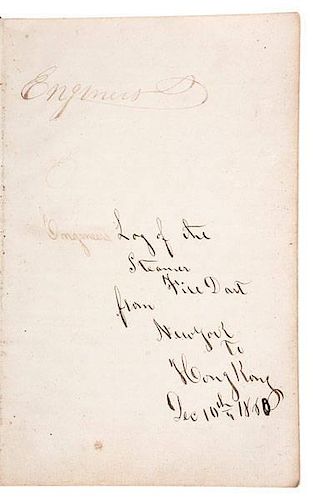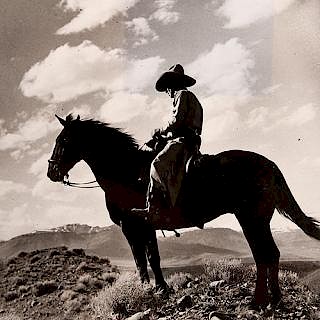Chief Engineer's Logbook for Steamers Fire Dart & Suwo Nada
About Seller
6270 Este Ave.
Cincinnati , OH 45232
United States
With offices in Cincinnati, Cleveland and Denver, Cowan’s holds over 40 auctions each year, with annual sales exceeding $16M. We reach buyers around the globe, and take pride in our reputation for integrity, customer service and great results. A full-service house, Cowan’s Auctions specializes in Am...Read more
Two ways to bid:
- Leave a max absentee bid and the platform will bid on your behalf up to your maximum bid during the live auction.
- Bid live during the auction and your bids will be submitted real-time to the auctioneer.
Bid Increments
| Price | Bid Increment |
|---|---|
| $0 | $25 |
| $500 | $50 |
| $1,000 | $100 |
| $2,000 | $250 |
| $5,000 | $500 |
| $10,000 | $1,000 |
| $20,000 | $2,500 |
| $50,000 | $5,000 |
| $100,000 | $10,000 |
About Auction
Jun 12, 2015 - Jun 13, 2015
Cowan's Auctions dawnie@cowans.com
- Lot Description
Memo book containing the daily entries of the chief engineer of the paddle-wheel merchant steamer Fire Dart on her maiden voyage from New York to Hong Kong in 1860, as well as a transcription of the 1865 voyage of the paddle-wheel steamer Suwo Nada, also from New York to Hong Kong.
The Fire Dart was one of the first ships of her type, purpose-built for the China trade and supplanting the "China clipper" sailing ships. She was also the first commercial steamship to ply the Yangtze River. The Suwo Nada was one of the last ships of this type, launched in 1864, and noted for her speed. Though steam-powered, they both were rigged for a full spread of sails as well, which were used to take advantage of favorable winds, or allow the engines to be serviced while remaining under way.
The Fire Dart left New York City on the morning of December 10, 1860, the same day delegates from South Carolina met with President James Buchanan to negotiate the peaceful transfer of Federal property to the state. The Fire Dart apparently outran all news from home, as no mention of secession or the formation of the Confederacy is found in the logbook. Her trip took her from New York to Rio, then to Cape Town, then the port of Galle in Ceylon. Running into monsoons after leaving Galle, the Fire Dart ate through so much coal that she had to put in at Saigon to purchase enough to make it to Singapore. From Singapore, she made the final leg to Hong Kong.
The chief engineer notes some small incidents in his log, related to the ship being on her maiden voyage. A shirt was found inside a boiler, clogging the intake, and fine coal dust in the bilges meant the leather seal on the bilge pump had to be repaired frequently, for instance.
The Suwo Nada, built for Augustine Heard & Co., spent the first months of her career running a route between New York, New Orleans, and Havana, as Confederate commerce raiders made the China trade too hazardous. In January, 1865, she was hired out as a troop transport for the Union Army at the rate of $810 a day. She served in the Carolinas campaign, being released from service on April 22. By the next month, she had been reconverted to her original role, and set out on her inaugural run to China. This log covers that voyage, running from New York to St. Vincent, then Rio. From there she makes landfall at Mauritius, then Singapore, and finally Hong Kong in September, making the trip from New York in 100 days (75 days of sailing.) A note near the end of the book mentions that the chief engineer left the Suwo Nada at Hong Kong in October, to ship aboard the steamer Kiang Loong.
Both logs record steam pressure, miles traveled, and coal consumed each day, with longitude and latitude noted as well. These two voyages appearing in the same log book have a symmetry about them. One ship left New York just prior to the secession of South Carolina, and the other left New York just after the end of the Civil War. One ship was one of the first of her kind, the other one of the last. Both were on their first trip to China, and both had the same man as chief engineer. - Shipping Info
-
SHIPPING. At the request of the buyer, Cowan's will authorize the shipment of purchased items. Shipments usually occur within two weeks after payment has been received. Shipment is generally made via UPS Ground service. Unless buyer gives special instructions, the shipping method shall be at the sole discretion of Cowan's Auctions, Inc.. Cowan's is in no way responsible for the acts or omissions of independent handlers, packers or shippers of purchased items or for any loss, damage or delay from the packing or shipping of any property.
-
- Buyer's Premium



 EUR
EUR CAD
CAD AUD
AUD GBP
GBP MXN
MXN HKD
HKD CNY
CNY MYR
MYR SEK
SEK SGD
SGD CHF
CHF THB
THB















